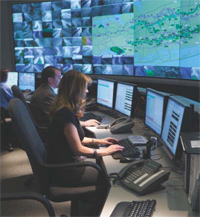Impacts of Technology Advancements on Transportation Management Center Operations
Chapter 1 – Introduction
1.1 Background
The rapid advancement and proliferation of technology continues to present TMC operators with both great challenges and great opportunities. Already, most TMCs have developed from primarily having a monitoring role into one requiring much more decision-making and proactive control, often involving multiple agencies and jurisdictions. While this has yielded significant benefits, the expectations of the public and of the funding agencies are only expected to increase while at the same time vehicle miles traveled will increase without significant physical capacity increases and funding for transportation will stagnate or decline. Intelligent Transportation Systems (ITS) are increasingly being tapped as cost-effective strategies. Diminishing resources will be monitored carefully so performance measurement will be a critical component in justifying effective TMC operations programs.
The context of this report is the many larger societal and technological trends that have implications to TMC operations, oftentimes driving the ITS trends and strategies described in Chapters 3 and 4, respectively. These big picture influencers are described in Chapter 2.

(Source: Parsons Brinckerhoff)
1.2 Report Objectives
This report stems from a need recognized by the Pooled Fund Study (PFS) members to better understand the trends and opportunities that will affect them, especially in the area of rapidly evolving technology. The objective of the report is, therefore, to identify and analyze potential impacts on TMC operations due to technology advancements in the next 10 years, and to suggest successful practices and strategies for TMC managers to best position themselves for maximum benefit.
To cover that objective over the 10-year technology horizon of the report, this report includes:
- Cutting edge practices already showing success for early adopters that can be spread;
- Insights into emerging technologies; and
- Ways that TMC operators can position themselves now to handle advances that we cannot yet predict.
This report, and future accompanying resources, will also be the basis for an outreach webinar.
1.3 Report Organization
This report covers a broad range of interconnected material. The structure below has been designed to present it logically if reading cover to cover and also if looking for specific information.
1.3.1 Chapter 1: Introduction
Chapter 1 provides the background, focusing on big picture influencers, as well as objectives and report organization.
1.3.2 Chapter 2: Literature Review
Chapter 2 provides a brief synopsis of the literature review.
1.3.3 Chapter 3: Top Trends and Issues of TMC Operation
Chapter 3 describes each of the top trends and issues of TMC operations that were developed in accordance with the report’s objectives based on the literature review and expert input, including the direction of the PFS members. They are listed in Figure 1.
Figure 1: Top Trends and Issues of TMC Operations

(Source: Parsons Brinckerhoff)
1.3.4 Chapter 4: Successful Practices and Strategies for TMC Managers
Chapter 4 presents 80 strategies that TMC managers can consider using to help them address the top 8 trends identified in Chapter 3. Many of the strategies address more than one of the top trends, but they are presented in groups by the trend they most directly address. For each strategy, a description, considerations, successful practices, key resources, and related trends are presented as applicable.
1.3.5 Chapter 5: Program-Level Implementation and Integration
Chapter 5 provides information that TMC managers can use to implement program-level changes that will enable them to take advantage of changing technologies to improve their operations. The recommendations, in the form of discussion, tools, and checklists, are categorized by:
- Technological and internal processes that can typically be influenced directly by the TMC manager, and
- Coordination of TMC processes within the broader organizational context.
1.3.6 Chapter 6: Summary and Conclusions
Chapter 6 provides a summary and conclusion for this work. It includes the TMC Manager Programmatic Checklist of Recommended Actions. It is designed to guide managers in using the content of the report.
1.3.7 Chapter 7: References
Chapter 7 serves as a bibliography for the report and a listing of useful references.